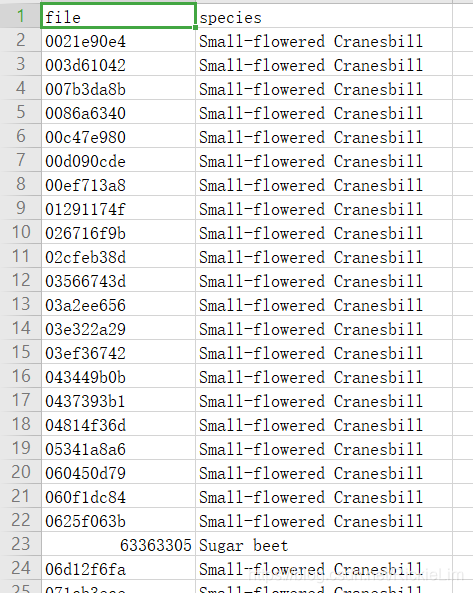学习并参考了这个链接。
提前准备:anaconda3(Jupyter);tensorflow;cv2;数据集(官网可以下,点开我给的超链接)
注意:tensorflow要求python是3.5/3.6版本的,已经配置了python3.7/3.8的朋友可以重新下载一个python 3.6,具体操作网上有很多教程可以参考~
基本思路:
- 读入图片 & 数据预处理
使用cv2。每个文件夹的名字就是其标签,但是名字不可以当作lable,所以建立了name_dic 字典转换为数字。由于每次加载数据很消耗时间,所以将四个文件(训练、测试集的特征和标签用numpy进行了保存)。另外由于图片数据过少,用到了图像增强。 - 搭建LeNet网络(CNN的一种)
- 训练模型
- 评价模型
话不多说,直接上代码,代码解释的很清楚了——
【对了,里面数据集的地址记得自己改。】
# 导入必要的包
from keras.models import Sequential
from keras.layers.convolutional import Conv2D
from keras.layers.convolutional import MaxPooling2D
from keras.layers.core import Dense,Dropout,Activation,Flatten
from keras import backend as K
from keras.preprocessing.image import ImageDataGenerator
from keras.optimizers import Adam
from sklearn.model_selection import train_test_split
from keras.preprocessing.image import img_to_array
from keras.utils import to_categorical # 用于one-hot编码
import matplotlib.pyplot as plt
import numpy as np
import cv2
import os
import pandas as pd
# 套用LeNet网络 (CNN,卷积神经网络)
class LeNet:
def build(width, height, depth, classes):
'''参数分别为:长 宽 高 分类'''
# 初始化模型
model = Sequential() # 建立线性堆叠模型
inputShape = (height, width, depth)
# if we are using "channels last", update the input shape
if K.image_data_format() == "channels_first": #for tensorflow
inputShape = (depth, height, width)
# first set of CONV => RELU => POOL layers
# 卷积1 过滤器大小为 5 * 5,会产生20个图像,卷积不会改变图像大小,起到了滤镜效果,设置ReLU激活函数
model.add(Conv2D(filters=20,kernel_size=(5, 5),padding="same",input_shape=inputShape,activation='relu'))
# 添加激活层
# model.add(Activation("relu"))
# 加入Dropout避免过拟合。
model.add(Dropout(0.25))
# 最大池化1 过滤器大小为 2 * 2,长和宽的步长均为2,不会改变图像的数量(仍旧是20),会改变大小(32*32变成16*16)
model.add(MaxPooling2D(pool_size=(2, 2), strides=(2, 2)))
#second set of CONV => RELU => POOL layers
# 卷积2 过滤器大小为 5 * 5,会产生50个图像,卷积不会改变图像大小,起到了滤镜效果,设置ReLU激活函数
model.add(Conv2D(filters=50, kernel_size = (5, 5), padding="same",activation='relu'))
# 激活函数
# model.add(Activation("relu"))
# 加入Dropout避免过拟合。
# model.add(Dropout(0.25))
# 最大池化2 过滤器大小为2 * 2,长和宽的步长均为2,不会改变图像的数量(仍旧是50),会改变大小(16*16变成8*8)
model.add(MaxPooling2D(pool_size=(2, 2), strides=(2, 2)))
# first (and only) set of FC => RELU layers
# Flatten层用来将输入“压平”
model.add(Flatten())
# Dense表示全连接层(500个神经元)
model.add(Dense(500))
model.add(Activation("relu"))
# 加入Dropout避免过拟合。
# model.add(Dropout(0.25))
# softmax classifier
# 建立输出层(分类数个神经元),softmax可以将输出预测为每一个图像的概率
model.add(Dense(classes,activation='softmax'))
# 多分类
model.add(Activation("softmax"))
# 查看模型的摘要
print(model.summary())
# 返回构建的网络架构
return model
#其中conv2d表示执行卷积,maxpooling2d表示执行最大池化,Activation表示特定的激活函数类型,Flatten层用来将输入“压平”,用于卷积层到全连接层的过渡,Dense表示全连接层(500个神经元)。
# 获取文件路径和标签
def get_files(file_dir):
# file_dir: 文件夹路径
# return: 乱序后的图片和标签
# 直接读取数据,会节约时间
if (os.path.exists('train_image_list1.csv.npy')
& os.path.exists('test_image_list1.csv.npy')
& os.path.exists('test_label_list.csv.npy')
&os.path.exists('train_label_list.csv.npy')
&os.path.exists('hunxiao.csv.npy')):
train_image_list_1 = np.load('train_image_list1.csv.npy')
train_label_list_1 = np.load('train_label_list.csv.npy')
test_image_list_1 = np.load('test_image_list1.csv.npy')
test_label_list_1 = np.load('test_label_list.csv.npy')
test_label_list = np.load('hunxiao.csv.npy')
print("训练集一共有%d张图\n" % len(train_label_list_1))
print("测试集一共有%d张图\n" % len(test_label_list_1))
return train_image_list_1, train_label_list_1, test_image_list_1, test_label_list_1,test_label_list
image_list = []
label_list = []
name_dic = {'Black-grass': 0, 'Charlock': 1, 'Cleavers': 2, 'Common Chickweed': 3, 'Common wheat': 4,
'Fat Hen': 5, 'Loose Silky-bent': 6, 'Maize': 7, 'Scentless Mayweed': 8, 'Shepherds Purse': 9,
'Small-flowered Cranesbill': 10, 'Sugar beet': 11}
# 载入数据路径并写入标签值
for file in os.listdir(file_dir):
name = str(file)
name_count = 0
for key in os.listdir(file_dir + file):
name_count+=1
image_list.append(file_dir + '\\' + file + '\\' + key)
label_list.append(name_dic[file])
print(name+"种类有"+str(name_count)+"张图片")
print("一共有%d张图\n" % len(image_list))
image_list = np.hstack(image_list)
label_list = np.hstack(label_list)
temp = np.array([image_list, label_list])
temp = temp.transpose() # 转置
np.random.shuffle(temp)
train_img, test_img = train_test_split(temp, train_size=0.7)
train_image_list = list(train_img[:, 0])
test_image_list = list(test_img[:, 0])
train_label_list = list(train_img[:, 1])
train_label_list = [int(i) for i in train_label_list]
test_label_list = list(test_img[:, 1])
test_label_list = [int(i) for i in test_label_list]
train_image_list1 = []
test_image_list1 = []
for m in range(len(train_image_list)):
image = cv2.imread(train_image_list[m])
# print(image.shape) # 查看部分图片的shape
image = cv2.resize(image, (norm_size, norm_size))
image = img_to_array(image)
train_image_list1.append(image)
for m in range(len(test_image_list)):
image1 = cv2.imread(test_image_list[m])
image1 = cv2.resize(image1, (norm_size, norm_size))
image1 = img_to_array(image1)
test_image_list1.append(image1)
# 标准化:提高模型预测精准度,加快收敛
train_image_list1 = np.array(train_image_list1, dtype="float") / 255.0
test_image_list1 = np.array(test_image_list1, dtype="float") / 255.0
# convert the labels from integers to vectors one-hot编码
train_label_list1 = to_categorical(train_label_list, num_classes=CLASS_NUM)
test_label_list1 = to_categorical(test_label_list, num_classes=CLASS_NUM)
# 第一运行 把处理好的数据保存下来
np.save('train_image_list1.csv',train_image_list1)
np.save('test_image_list1.csv',test_image_list1)
np.save('test_label_list.csv',test_label_list1)
np.save('train_label_list.csv',train_label_list1)
np.save('hunxiao.csv',test_label_list)
return train_image_list1,train_label_list1,test_image_list1,test_label_list1,np.array(test_label_list)
def show_train_history(H):
# 绘制训练损失和准确性
plt.style.use("ggplot")
plt.figure()
N = EPOCHS # 训练周期数
plt.plot(np.arange(0, N), H.history["loss"], label="train_loss")
plt.plot(np.arange(0, N), H.history["val_loss"], label="val_loss")
plt.plot(np.arange(0, N), H.history["acc"], label="train_acc")
plt.plot(np.arange(0, N), H.history["val_acc"], label="val_acc")
plt.title("Training Loss and Accuracy on traffic-sign classifier")
plt.xlabel("Epoch #")
plt.ylabel("Loss/Accuracy")
plt.legend(loc="lower left")
plt.savefig('plot.png')
plt.show()
def train(aug, trainX, trainY, testX, testY,test_label_list):
# 初始化模型
print("开始构建模型···")
model = LeNet.build(width=norm_size, height=norm_size, depth=3, classes=CLASS_NUM)
# 加载已经存在的模型
try:
model.load_weights('saveModel/plant_sign.model')
print("加载模型成功!继续训练模型")
except:
print("加载模型失败!开始训练一个新的模型")
print("定义训练方式···")
# 定义训练方式,三个参数,分别是loss:设置损失函数;optimizer:使用adam优化器收敛更快,metrics:设置评估模型的方式是准确率
opt = Adam(lr=INIT_LR, decay=INIT_LR / EPOCHS)
model.compile(loss="categorical_crossentropy", optimizer=opt,
metrics=["accuracy"])
# train the network,开始训练
print("开始训练网络···")
H = model.fit_generator(aug.flow(trainX, trainY, batch_size=BS),
validation_data=(testX, testY), steps_per_epoch=len(trainX) // BS,
epochs=EPOCHS, verbose=1)
# 输入训练数据集,划分方式是0.8+0.2 训练20个训练周期,每一个批次128项数据,verbose=2为显示训练过程
predY = model.predict_classes(testX)
# print(predY.shape)
# print(test_label_list.shape)
# 打印混淆矩阵
matrix = pd.crosstab(test_label_list,predY, rownames=['label'], colnames=['predict'])
print(matrix)
# save the model to disk
print("[INFO] serializing network...")
# model.save('saveModel/traffic_sign_result.model') # 保存模型
# 画出准确率执行结果
show_train_history(H)
# prediction_probability = model.predict(True_Train_X) # 预测可能性
# prediction = model.predict_classes(True_Train_X) # 直接预测分类结果
EPOCHS = 32 # 迭代次数
INIT_LR = 1e-3
BS = 32
CLASS_NUM = 12
norm_size = 32
# 主函数
if __name__=='__main__':
# train_file_path = "../dataset\\"
train_file_path = "C:/Users/LRK/Desktop/plant-seedlings-classification/test"
trainX,trainY,testX,testY,test_label_list = get_files(train_file_path) # 导入数据集
aug = ImageDataGenerator(rotation_range=30, width_shift_range=0.1,
height_shift_range=0.1, shear_range=0.2, zoom_range=0.2,
horizontal_flip=True, fill_mode="nearest")
train(aug, trainX, trainY, testX, testY,test_label_list)
# 下面开始predict!!
import tensorflow as tf
import keras
#import lenet
import os
from keras.preprocessing.image import ImageDataGenerator
from keras.utils import plot_model
import cv2
import numpy as np
import pandas as pd
from keras.preprocessing.image import img_to_array
def get_file(path):
test_list = []
test_name_list = []
for file in os.listdir(path):
image = cv2.imread(path+'/'+file )
image = cv2.resize(image, (norm_size, norm_size))
image = img_to_array(image)
test_list.append(image)
file_list_split = file.split(".")
test_name_list.append(file_list_split[0])
test_list = np.array(test_list, dtype="float") / 255.0
return test_list,test_name_list
norm_size = 32
if __name__ == '__main__':
name_dic = {'0': 'Black-grass', '1': 'Charlock', '2': 'Cleavers',
'3': 'Common Chickweed', '4': 'Common wheat',
'5': 'Fat Hen', '6': 'Loose Silky-bent', '7': 'Maize',
'8': 'Scentless Mayweed', '9': 'Shepherds Purse',
'10': 'Small-flowered Cranesbill', '11': 'Sugar beet'}
path = "C:/Users/LRK/Desktop/plant-seedlings-classification/test"
test_list, test_name_list=get_file(path)
# model = lenet_model.LeNet.build(width=32, height=32, depth=3, classes=12)
model = LeNet.build(width=32, height=32, depth=3, classes=12)
try:
model.load_weights('saveModel/traffic_sign_w.model')
print("加载模型成功!继续训练模型")
except:
print("加载模型失败!开始训练一个新的模型")
# 可视化模型
# plot_model(model, to_file='model.png') 图像增强
aug = ImageDataGenerator(rotation_range=30, width_shift_range=0.1,
height_shift_range=0.1, shear_range=0.2, zoom_range=0.2,
horizontal_flip=True, fill_mode="nearest")
aug.flow(test_list)
result = model.predict_classes(test_list)
name_list = []
for i in result:
name_list.append(name_dic[str(i)])
finally_result = pd.DataFrame({'file':test_name_list,'species':name_list})
print(finally_result)
finally_result.to_csv("C:/Users/LRK/Desktop/plant-seedlings-classification/0304.csv",index=False)
# print(finally_result1)
运行到最后,自己创建一个新的csv文件然后把地址填上代码里,代码会把分类结果写进去,就像下面这样,即分类完成——

